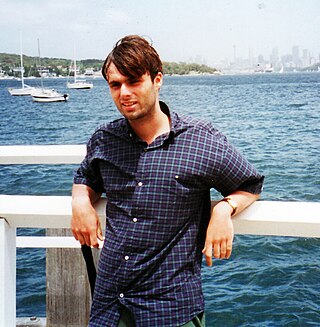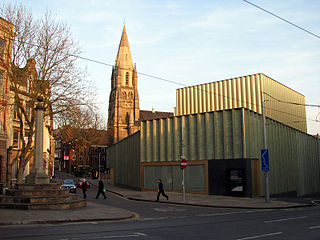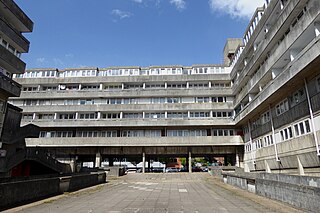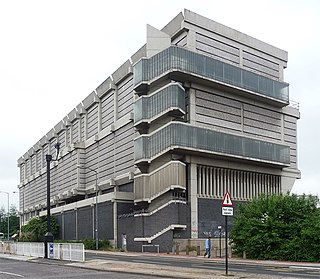Ian Douglas Nairn was a British architectural critic who coined the word "Subtopia" to indicate drab suburbs that look identical through unimaginative town-planning. He published two strongly personalised critiques of London and Paris, and collaborated with Sir Nikolaus Pevsner, who considered his reports to be too subjective, but acknowledged him as the better writer.

Jason Barker is a British theorist of contemporary French philosophy, novelist, film director, screenwriter, and producer. He is a professor of cultural studies at Kyung Hee University in the Graduate School of British and American Language and Culture, and visiting professor at the European Graduate School, where he teaches in the Faculty of Media and Communication alongside Alain Badiou, Judith Butler, Jacques Rancière, Avital Ronell, Slavoj Žižek, and others.

Nottingham Contemporary is a contemporary art centre in the Lace Market area of Nottingham. The gallery opened in 2009.

Owen Hatherley is a British writer and journalist based in London who writes primarily on architecture, politics and culture.

West Properties (UK) Ltd is a United Kingdom based property development company. The company focuses on high-end development projects, including Skyline Central, Lumiere, and Vivo in Manchester. Revenue for the 2008 fiscal year fell from £13.9m, down sharply from £26m the previous year.

The Jubilee Library is the largest running public library in the English city of Brighton and Hove. The Jubilee Library forms part of the Jubilee Square development in central Brighton, as a £50 million endeavour to regenerate a 40-year-old brownfield site. Opened in 2005 by the Princess Royal, the library has won several architectural design awards, and on one occasion dubbed, "A triumph" by the Pevsner Architectural Guides. In terms of the number of daily visitors, the library is one of the busiest in England. The library brought together facilities previously housed in separate sites.
The Holyrood estate is a housing estate in Southampton, England. It was constructed as a new city district to replace a slum bombed in World War II, and designed by Lyons Israel Ellis, who later designed Wyndham Court. Owen Hatherley describes the estate as a "straightforward scattering of low and medium-rise Modernist blocks, using the soft-Brutalist vernacular of stock-brick and concrete." Hatherley praises the estate's layout over its aesthetic. The estate is situated between Queensway to the west and Threefield Lane to the east, and Bernard Street to the south and Lime Street to the north.

Wyndham Court is a block of social housing in Southampton, England. It was designed by Lyons Israel Ellis for Southampton City Council in 1966, and is located near Southampton Central station and the Mayflower Theatre. Wyndham Court includes 184 flats, three cafes or restaurants and 13 shops, and was completed in 1969.

The Moore Street electricity substation is an electrical substation in Sheffield, England, designed by Jefferson Sheard in 1968. The substation is an example of Brutalist architecture. Owen Hatherley describes it as "a shocking paroxysm of a building, an explosion in reinforced concrete, a bunker built with an aesthete's attention to detail, a building which is genuinely Brutalist in both senses of the term."

The National Union of Mineworkers headquarters is a building in Sheffield, England which formerly housed the head office of the National Union of Mineworkers (NUM).
Laura Oldfield Ford, also known as Laura Grace Ford, is a British artist and author. Her mixed media and multimedia work, encompassing psychogeography, poetry and prose, photography, ballpoint pen, acrylic paint and spray paint, explores political themes and focuses on British urban areas. Her zine Savage Messiah, which centres on London, was published from 2005 to 2009 and collected as a book in 2011.

UCL Urban Laboratory is a cross-disciplinary centre for the study of cities and urbanism, based at University College London. It carries out research, education and outreach activities both in London and internationally. The Urban Laboratory was established in 2005. UCL Urban Lab is a department of the Bartlett Faculty of the Built Environment which also co-operates with the faculties of Engineering, Social and Historical Sciences; and Arts and Humanities. The current director and Head of Department is Dr Clare Melhuish, who took on the role from Dr Ben Campkin in 2018.

Marchwood ERF is a waste incineration plant in Marchwood, near Southampton, England. It is situated beside the estuary of the River Test where it meets Southampton Water, opposite the Port of Southampton. It burns municipal waste and produces electricity for the National Grid.

The Revenge of History: The Battle for the Twenty-First Century is a 2012 book by British journalist and writer Seumas Milne. An updated edition was published in 2013.
Georgie Wolton was a British architect, an original member of the architecture firm Team 4. Critic Jonathan Meades describes her as the "outstanding woman architect of the generation before Zaha [Hadid]".

The House for the Future, sometimes called House of the Future and more recently renamed Ty Gwyrdd, is a modern house located in the St Fagans National History Museum on the western edge of Cardiff, Wales. Completed in 2000, it was originally a showcase of the latest green building technologies, but was later transformed into an education centre. It was described by architectural writer Owen Hatherley as "a rather ambitiuous gesture for a place devoted to reconstructing the past".

Hove Town Hall is the headquarters of Brighton and Hove City Council. The current building was constructed in 1970 in the Brutalist style by John Wells-Thorpe, to replace the original 1882 Hall which was damaged by fire in 1966.

Central Hill is a social housing estate in the London Borough of Lambeth. It was designed by Rosemary Stjernstedt, Roger Westman and the Lambeth Council planning department during the directorship of Ted Hollamby. It comprises more than 450 homes built in 1966-74 near the site of the former Crystal Palace. Lambeth Council plans to demolish the estate so that it can build an extra 400 homes, many for private sale, so that it can finance the construction of new social housing.

High Point is a high rise former commercial building in Bradford, in West Yorkshire, England. It is a prominent example of Brutalist architecture. Designed by John Brunton Partnership of Bradford, it was completed in 1972 to serve as the headquarters of the Yorkshire Building Society but went unused for decades.

Ievgeniia "Jenia" Gubkina is a Ukrainian architect, architectural and urban historian, and curator specializing in architecture and urban planning of the 20th century in Ukraine, and a multidisciplinary approach to heritage studies. Since 2014 she has co-founded the NGO Urban Forms Center and the avant-garde women's movement "Modernistki".
















